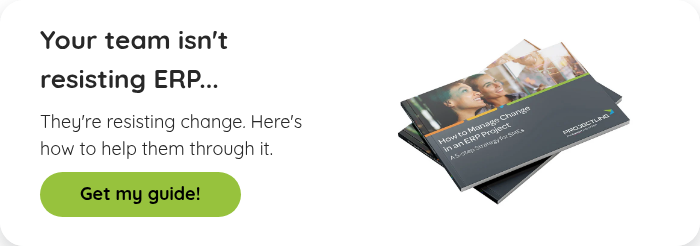Blog
Share this
4 ERP Change Management Tips to Ease the Transition for Your Team

by Jalene Ippolito on August 31, 2020
From the outside, implementing a new ERP system is about technology. But at the core, it’s a combination of technology, process and, most importantly, people. Organizations that overlook the people component are more likely to experience a failed ERP project, because the resistance to change is high and it isn’t being addressed. It all comes down to uncertainty. And it needs to be managed properly for your ERP project to be a success.
How? By making change management a key component of your ERP project. The goal is to use a structured process to prepare your employees for change and ease the transition to your new system. When done properly, from the beginning of the project, change management will allow you to reduce resistance, increase adoption and give your people confidence in the new direction.
1. Make the case for change
The first step to embracing change is understanding why it’s needed. Explain to your entire team why you’re starting an ERP project. What are the challenges you’re facing with your current systems? How do you see an ERP system solving these challenges? What are the benefits to the company, to departments and to individuals? How will the system support your future growth? Answering these questions early on will help your team focus on the end goal. But don’t just say it once. Reinforce the reason why consistently throughout the project. At various points during the implementation, the demand on your team will be high. These are the times where you need to remind them why the project is important and how it will benefit them.
2. Be strategic about managing your biggest resistors
Throughout your company, you’ll have project supporters – the ones who see the value and are motivated to make it a success. And you’ll have resistors – the people who strongly dislike change and may dig in their heels. Even if they see the flaws in your current system, they might be more comfortable with ‘the devil they know’. Knowing who these individuals are and creating a plan to manage them is crucial to minimizing the risk to your project.
Think about the cultural changes the implementation will create. Changes to process will change the way people work. Think about how that impacts the individuals on your team. It might be tempting to use a broad brush and outline how the changes will affect different teams or departments. But you need to consider individual personalities, as each person will respond differently. Conducting organization and people readiness assessments early on can help you identify the risks and opportunities. Based on the results, you can create an action plan to manage the resistors throughout the project. Set check-in points mid-project and post-implementation to see how you're progressing.
3. Develop a plan for consistent communication
One of the biggest mistakes that companies make is thinking they’ll communicate with their team as there’s something to share. The challenge is that communication becomes an after-thought among all the other project activities. It happens infrequently and doesn’t provide the information your people are looking for. And without the information, your people will start to fill in the blanks on their own.
Studies have shown that effective communication is closely linked to success. Developing a plan and sticking to it is the cornerstone of good change management. When developing your ERP project team, select individuals with strong communication skills. This will make your project team more effective and will prove valuable as members of your team are communicating with their functional groups. From an organizational perspective, think about the following as you develop your plan:
- What do we need to communicate?
- Why is the information being shared?
- Who are we sharing it with? You’ll want to share some information with the entire organization, but you’ll also have cases where it’s limited to the project team or specific departments.
- Who is the best person to communicate the message? Your executive sponsor should be the one communicating why the project is necessary, as it’s most effective coming from the top down. Ongoing status updates likely make more sense coming from your project champion.
- When is the best time to communicate? Think about milestones at various points throughout the project.
- How will the information be shared? Many people default to email, which will make sense in many cases (like status updates, for example). But keep in mind that the purpose of change management is to ease the transition for your people. Sometimes this is best done through in-person conversations or even a phone call, particularly when dealing with your biggest resistors to change.
4. Enable your workforce
Enabling your team is about more than just system training. First, you need to understand how the change will impact individual employees. Consider what will change in their role, what new skills they might need to develop and how you can support their learning. For example, if you’re coming from a system that had very limited reporting capabilities, your employees may not fully understand how to read and analyze the reports in your new ERP system. In this case, simply training someone on how to run the report won’t suffice.
When it comes to training, talk with your people to understand how they learn best. Some people want the deep-dive hands-on training. Others prefer to watch videos or reference a training manual. Try to adapt your training program to the way your employees learn best. And be sure to plan for ongoing training. It shouldn’t end when the project does. Many implementation partners offer regular training opportunities, in the form of webinars, on-demand videos or help center articles.
Closing Thoughts
There are many factors that can impact ERP implementation success, but effective change management is arguably one of the most important. If your people aren’t on board and feeling supported through the change, you won’t be able to fully leverage the power of your new system. And keep in mind, the larger the organization, the greater the need to have resources dedicated to oversee change management.
Share this
Stay in the Know!
Join other SMEs who receive our monthly ERP insights, tips and best practices.
You may also like

ERP Funding for Canadian Businesses

Should You Work with a NetSuite Implementation Partner or Go Direct?



